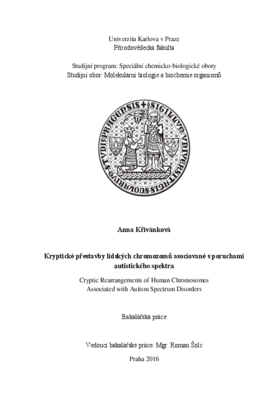Kryptické přestavby lidských chromozomů asociované s poruchami autistického spektra
Cryptic Rearrangements of Human Chromosomes Associated with Autism Spectrum Disorders
bakalářská práce (OBHÁJENO)

Zobrazit/
Trvalý odkaz
http://hdl.handle.net/20.500.11956/79986Identifikátory
SIS: 167053
Katalog UK: 990020920650106986
Kolekce
- Kvalifikační práce [21484]
Autor
Vedoucí práce
Oponent práce
Růžičková, Šárka
Fakulta / součást
Přírodovědecká fakulta
Obor
Molekulární biologie a biochemie organismů
Katedra / ústav / klinika
Katedra antropologie a genetiky člověka
Datum obhajoby
7. 6. 2016
Nakladatel
Univerzita Karlova, Přírodovědecká fakultaJazyk
Čeština
Známka
Dobře
Klíčová slova (česky)
poruchy autistického spektra, mikrodelece, mikroduplikace, variabilita počtu kopií, nealelická homologní rekombinace, repetitivní sekvence o nízkém počtu opakováníKlíčová slova (anglicky)
autism spectrum disorders, microdeletion, microduplication, copy number variants, non-allelic homologous recombination, low-copy repeatsPoruchy autistického spektra (PAS) jsou heterogenní skupinou neurovývojových postižení charakteristické asocialitou a atypickými vzorci chování. Etiologie je velmi komplexní, autismus většinou vzniká spojením několika faktorů. Jedna z příčin vzniku může být genetická (mutace genů). Dosud je známo kolem 450 kandidátních genů PAS. Minoritní část z nich se vyskytuje v lokusech, které jsou ovlivňovány kryptickými přestavbami. Tyto aberace výrazně přispívají k projevům autismu. Patologie, které způsobují, vedou k syndromům s vysokou penetrancí pro PAS, jako je například Angelmanův/Prader-Willi nebo DiGeorgův syndrom. Další lokusy jsou nalézány často na chromosomech 1, 2, nebo 16. Vzhledem ke krátké době, po kterou jsou kryptické přestavby zkoumány, k fenotypové variabilitě a počtu pacientů, můžeme v budoucnu očekávat nárůst vědeckých studií, v nichž by neměl být opomenut vliv těchto přestaveb na vznik poruch autistického spektra.
Autism spectrum disorders (ASD) are heterogeneous group of neurodevelopmental disabilities characterized by antisociality and atypical behavioral patterns. Its etiology is very complex, autism is usually formed by combining many factors. One of the causes may be genetic (gene mutation). It is known about 450 candidate genes for ASD so far. Minority of these genes occur in loci which are affected by cryptic rearrangements. These rearrangements significantly contribute to manifestation of this disorder. Patologies they cause, lead to syndromes with high penetrance for ASD such as Angelman/Prader-Willi or DiGeorge syndrome. Other loci are found on chromosome 1, 2 or 16. Due to short time of studies of cryptic rearrangements, phenotypic variability and number of patients we can expect more researches in the future. These researches are expected not to overlook the impact of the aberrations on formation of autism spectrum disorders.
